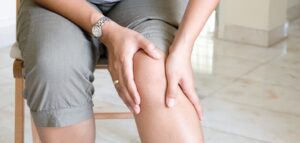How to Avoid Chronic Pain Triggers

Back to physical health resource hub
Approximately one in three people will experience chronic pain.
What is chronic pain? It is a pain that lasts longer than it should. For example, if a sprained ankle ligament has healed in 4 weeks but the ankle still hurts after 12 weeks, it may be a case of chronic pain.
Chronic pain can also be a recurrent pain that comes back every few months for no obvious reason.
But why does pain last longer than it’s supposed to? What makes one person’s pain temporary and the other chronic?
There are many factors that may contribute to the development of chronic pain, including:
- Overall fitness level – If your fitness level is low, you may be at greater risk. Stronger tissues can usually sustain injury and recover better than weaker tissues.
- Habitual poor posture – Years of poor posture may make one vulnerable to cumulative strain and then – pain.
- Age – We don’t like to hear it, but age can leave one susceptible to slow healing and increased pain as time goes by.
- Nutrition – More and more information is developing about the relationship between what we eat and how we feel. Consistent use of junk foods, alcohol, smoking and poor eating habits increase the likelihood of pain sensitivity.
- Poor lifting techniques – Similar to poor posture, poor lifting techniques can take a toll on one’s body.
- Stress – Although not a physical issue, emotional stress can have negative physical consequences, like pain.
- Congenital or genetic issues– Changes from birth or even genetics can have a role in how one’s body responds to injury and stress.
- Behavior and coping style – How we respond to pain and how we choose to cope with pain when it occurs can have a negative effect on pain. For instance, if we respond to pain through decreasing activity, that will cause additional problems over time.
So what’s a person to do? Here are quick tips to help manage chronic pain:
Exercise: Yes, even if you don’t feel like it. Begin moving something. The best way to lubricate joints and protect cartilage is through movement. And, by moving you begin to develop more endurance and strength to manage daily activities with less fatigue – and pain.
Eat wisely: Just like mom said, “You are what you eat”. Begin to incorporate more wholesome foods in your diet. Reduce the use of processed foods that often come with pro-inflammatory chemicals which only make you feel worse in the long run. Even the single choice to drink water keeps you more hydrated and wards off dehydration better than other drinks. Dehydration can contribute to increases muscle soreness and spasm.
Relax: If you can’t change the stress in your life, then consider changing how you respond to it. The traffic jam can wind you up and make your body so tense that pain seems to increase. Or you can learn to get less distressed with things you can’t control – and avoid the flare up of pain that comes with increased stress.
Socialize: Stay connected with friends and family who can offer support and encouragement. Staying engaged with something or someone else can also be a source of distraction that helps decrease pain intensity.
There are many complex factors that can contribute to chronic pain. If you have chronic pain and would like more information on our comprehensive pain rehabilitation program please contact [email protected] for a consultation.


